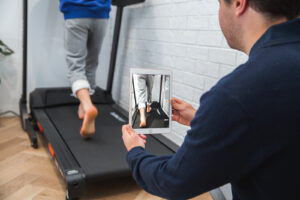If you are suffering from foot pain it is definitely worthwhile having a biomechanical assessment performed on your feet. Here at Be Podiatry, all of our practitioners have experience with dealing with a range of different foot pathologies and conduct our assessments with a structured approach to ensure everyone receives a detailed examination. The overall purpose of this assessment is quite simple and is to check how the feet are functioning and how this could be contributing to your symptoms.
So what is involved?
History:
The first step our podiatrists will take is conducting an extensive history. This is an informal and friendly chat between practitioner and patient where we are essentially undertaking an audit of your lifestyle. Our podiatrist will ask you to define what your goal is so we can best work together to help you achieve it. Throughout this chat we will touch on many different areas including the specifics about the nature of pain, previous treatments that you have trialled, previous injuries, any relevant medical history, physical activities or sports and occupation among much more.
Observation:
At this point our podiatrist will take a broad look at the feet while you are sitting back relaxing in the treatment chair. We are looking for any signs, clues or points of interest which could possibly be contributing to your presenting complaint. Your podiatrist will inspect the toes, ball of the foot and heels for any signs of callous or corns. Callous and corns form due to excessive pressure on certain areas of the foot and can paint a picture for how your feet are functioning when walking. We will also take note of any bunions, clawed toes, hammer toes, bony prominences and the overall position of your foot when it is in a relaxed position.
Any shoes you have brought in will also be assessed at this point. Features including width, depth, fixation and arch support will be analysed to see whether the shoe is an appropriate fit. The shoes wear patterns will be checked to see how much tread has been worn down to give an indication of where high pressure areas are occurring under your feet. After this a recommendation will be provided on the suitability of the shoes for your current lifestyle.
Assessment:
This part of the consultation is where we start to get more specific with our assessments. In this phase we are looking for any discrepancies or differences between the feet. Joint range of motion will be performed to gain an understanding of how the feet are moving and to check for any restrictions or limitations in range. Muscle testing will be undertaken to look for any weaknesses or compensations that may be occurring. This may include resisted muscle testing and more functional tests such as calf raises, hopping, lunges, squats ect. Foot posture will be examined to determine if you have a flatter or higher arched foot and whether this is impacting on the movement of your feet.
Palpation of the tissues within the foot and ankle is also a key component here. This aims to identify which specific structure is causing pain or discomfort. Your podiatrist will palpate muscles, tendons, ligaments and bone to try and reproduce your symptoms. This will help to formulate differential diagnosis.
Next, a visual gait analysis will be conducted. Our podiatrist will use an iPad to record your natural walking or running gait. This will give us an insight for how your feet function when you are weight bearing. From the gait assessment we will be able to break down the key aspects and identify any anomalies that are contributing to excess load to being placed upon the injured or painful tissue. This video will also be used as a comparison and reference point from which we can base our progress from in future appointments.

Management and treatment:
After all of our assessments have been completed we will move into the treatment phase. A diagnosis or reason for your symptoms will be provided and discussed with you. Depending on the injury or cause of your pain our podiatrist will likely provide a combination of education, strengthening exercises, padding, taping, wedging, footwear changes, foot orthoses, shockwave and laser therapy. This will differ between each individual for what treatment modality is implemented as certain treatments may work better for specific conditions. After treatment, you will be provided a detailedmanagement plan outlining what we have implemented and what will be done in the coming weeks.

